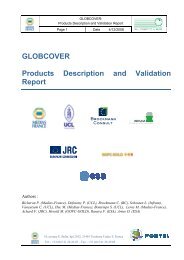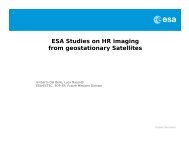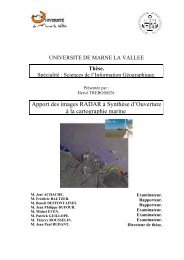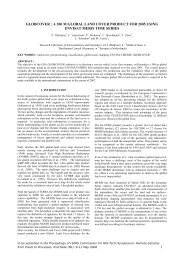Medspiration â System Requirements Document - Data User Element
Medspiration â System Requirements Document - Data User Element
Medspiration â System Requirements Document - Data User Element
Create successful ePaper yourself
Turn your PDF publications into a flip-book with our unique Google optimized e-Paper software.
<strong>Medspiration</strong><br />
<strong>System</strong> <strong>Requirements</strong> <strong>Document</strong><br />
same.<br />
MED-SOC-RS-001_1<br />
Issue F<br />
SR.MDB.0220/I The colocation method will be the same for each satellite product<br />
regardless of their resolution.<br />
It is stated in the GDS that, for coarser resolution (typically 25 km), the mean of a<br />
transect of several measurements obtained within the grid cell will be preferred to a<br />
single point observation. This solution introduces a lot of complexity because of the<br />
ancillary parameters provided with the in-situ measurements (for instance ship speed or<br />
heading, location, sensor identifiers) which can’t be averaged and because in-situ<br />
observations may come from different sensors and platforms. In addition, a mean<br />
observation could be computed from both day-time or night-time measurements. It is<br />
proposed to use the same algorithm as for high resolution measurements.<br />
SR.MDB.0230/I The time and space constraints are stored in a configuration file<br />
(MDB_time_constraint and MDB_space_contraint variables) for each L2P dataset.<br />
These colocation criteria shall be defined and maintained by the GHRSST-PP<br />
International Project Office.<br />
SR.MDB.0240/I The space/time criteria shall be set as the largest as acceptable<br />
(typically 25km in space and 6 hours in time). These criteria may be strengthened when<br />
filtering out the data from the MDB at GDAC, for instance to take into account the<br />
day/night asymmetry, but not when generating the MDB records at RDAC in order to add<br />
more flexibility and extendibility.<br />
It is stated in the GDS that “because of the day-night asymmetry in the growth and decay<br />
of the diurnal thermocline, more stringent conditions for acceptable time intervals may be<br />
required during the day than at night. For these and ambiguous cases, such as close to<br />
the terminator, the smallest spatial separation and shortest possible time interval should<br />
be sought”. It is not clear if this should be taken into account for the MDB records<br />
generation or when retrieving the data records from the database, which allows more<br />
flexibility (easier to generate the most complete MDB dataset and then filter out when<br />
extracting the data). Moreover the definition and the computation of the day/night<br />
threshold need to be provided in order to ensure consistency through RDACs.<br />
SR.MDB.0250/I An in-situ measurement shall be colocated to only one pixel of each L2P<br />
dataset.<br />
This is a refinement from the GDS which states that only one instance of each in situ<br />
observation for each individual satellite sensor should occur within the MDB which is<br />
© 2004 SOC Page 50 of 193








